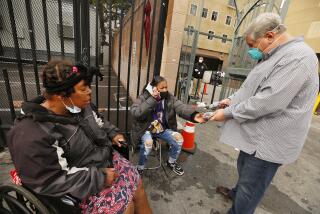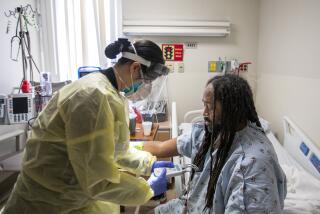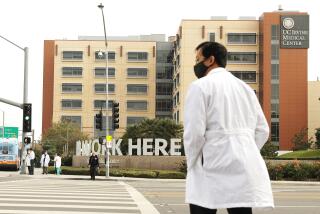Seeking the Rx for Germ Attack
- Share via
Acknowledging that local hospitals lack the tools to handle a chemical or biological attack, Orange County health officials are racing to plug sizable gaps in readiness plans.
The county plans to spend nearly $2 million through the end of the year to purchase more drugs and medical supplies as well as create a coordinated response plan linking hospitals, paramedics and other emergency services agencies.
While experts said it is impossible to fully prepare for a massive attack, they agree hospitals can do more to mount a basic response.
Hospitals said they lack adequate staffing as well as antidotes to deal with such an attack. Orange County’s largest trauma center, UCI Medical Center in Orange, has only enough antidotes to treat 15 nerve-gas patients and five victims of biological warfare.
The hospital doesn’t have the money to stockpile more antidotes, officials said, and lacks the beds needed to treat more than a few victims at a time.
“Are we where we want to be? Absolutely not,” said Dr. Carl Schultz, a UCI emergency room doctor who specializes in disaster medicine. “We have a ways to go.”
The problems are underscored by a confidential federal report that found some local hospitals did a poor job treating “victims” during a large law-enforcement drill last year that simulated a sarin gas attack at Edison Field in Anaheim.
Officials worry that hospitals face a critical shortage of protective suits and masks that are essential to keep doctors and nurses from becoming infected. And some hospitals lack the equipment to quickly decontaminate victims of a chemical attack who might walk in off the street.
In response to the concerns, Orange County is planning to spend federal grant money on more drug and equipment purchases as well as improve coordination and communications among hospitals and other emergency workers.
County officials said they were already moving to improve stockpiles even before the Sept. 11 terrorist attacks. But now the county is pushing ahead with even greater urgency in an effort to have hospitals better equipped by year’s end, though they stress that the chances of an assault remain rare.
“The original deadline [for purchasing supplies and medicine] was next March, but I think given what’s happened we want to speed that up as quickly as possible,” said Dr. Bruce Haynes, medical director for Orange County’s emergency medical services.
By improving communications among hospitals, the county hopes doctors will keep in touch about possible outbreaks of diseases that might signal a germ warfare attack and quickly determine which hospitals have what sorts of antidotes, officials said.
Among the most critical problems facing hospitals is the ability to wash off chemicals from victims. In Tokyo, thousands of victims walked into medical centers after terrorists unleashed a deadly nerve gas on the city’s subway in 1995.
Hoag Memorial Hospital Presbyterian in Newport Beach has a better setup than many medical centers. Doctors there have three showers to scrub victims clean of chemicals and a plan to isolate victims from other patients. But even there, hospital officials acknowledged that they would have trouble handling mass casualties.
“There’s nothing we can do to prepare for that,” said Steve Moreau, the hospital’s senior vice president.
Hospitals frequently suffer from bed shortages. In the event of a large number of casualties, doctors would have to convert hospital corridors and parking lots into triage areas.
“If something happened and there was a huge increase in demand, there’s no surge capacity to suddenly absorb a number of patients,” UCI’s Schultz said. “No hospital in Orange County is prepared to deal with hundreds of people coming in all at once.”
Schultz said doctors are also concerned about how few protective suits are available for hospital staff. UCI, he said, has only three or four now in the emergency room, each of them little more than “street clothes.” The type of suits worn by military personnel and firefighters offer the level of protection doctors and nurses would prefer, but are too cumbersome for medical tasks Schultz said.
The effort to ensure hospitals are prepared follows years of training and equipping police officers, paramedics and other emergency workers.
Now, the federal government is trying to help hospitals nationwide catch up, doling out more than $53 million in grants to local health officials in the last few years.
While experts say the chances of such an attack remain slim, concerns have mounted since the Sept. 11 terrorist attacks and the Friday death of a Florida man from inhaled anthrax.
Last week, the county’s top public health officials simulated a biological attack in Huntington Beach to test readiness. And on Monday, the Columbus Day holiday, health officials were put on call in case trouble occurred.
Times Staff Writer David Reyes contributed to this report.
More to Read
Sign up for Essential California
The most important California stories and recommendations in your inbox every morning.
You may occasionally receive promotional content from the Los Angeles Times.











